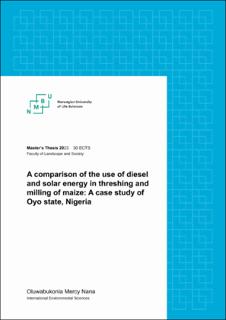| dc.description.abstract | The increasing demand for sustainable and efficient agricultural practices calls for the exploration of alternative energy sources in the agricultural mechanization value chain. This study aims to compare the utilization of diesel and solar energy in the threshing and milling operations of maize in Oyo state, Nigeria. Focusing on the potential to replace conventional energy sources, determining energy demand in threshing and milling, and examining how the adoption of solar energy can replace fossil energy in these operations. The research was conducted in the south-western Nigerian state of Oyo, with 90 maize farmers, 9 maize-mill operators, and 9 maize thresher operators participating in the study.
Through a comprehensive analysis of survey data and statistical calculations, the study reveals significant findings. It demonstrates that solar energy can replace conventional energy sources in threshing and milling. The research identifies barriers to the adoption of solar energy, including lack of government support, high installation costs, and the cost of electricity. However, the study also highlights the environmental benefits of solar energy, as emissions resulting from diesel-powered operations were found to be 195 kg (0.195 tons).
The analysis of energy demand demonstrated that the average energy consumption for threshing operations was 0.005 liters per kilogram (kg) of maize, while for milling operations, it was 0.014 liters per kg. The total fuel cost for running these operations using diesel was found to be 2,382,445 Naira. In contrast, the computation presented the aggregate expense of solar panel installation for the same operations, which amounted to 2,442,000 Naira (including the initial cost of solar panels and installation). Although the upfront cost for solar panels was slightly higher than the annual fuel cost, further evaluation highlighted the long-term advantages and cost savings associated with solar energy.
Furthermore, considering the prevailing diesel price in Nigeria (828 Naira per liter) and the electricity price from the national grid (70 Naira per kilowatt-hour), the study compared the annual costs of using diesel and solar energy. The analysis indicated that the cost of electricity from the national grid for the energy demand of the operations (calculated at 28770 kWh with a 20% energy loss) amounted to approximately 1,000,000 Naira. Electricity from the grid is also an environmentally friendly option as this energy is produced from hydroelectric power plants. It therefore seems interesting to use electricity from the grid rather than to use diesel to run the threshers and mills
The study recommends collaborative efforts between policymakers, renewable energy companies, and agricultural stakeholders to address the identified barriers. Financial support, such as subsidies and grants, should be provided to assist farmers and operators in the initial investment of solar panels and installation costs. Awareness programs should also be conducted to educate the agricultural community about the advantages of solar energy.
Additionally, future research should focus on technological advancements specific to solar energy in the agricultural sector, including improving the efficiency of solar-powered machinery, developing cost-effective storage solutions, and optimizing energy distribution. | |
